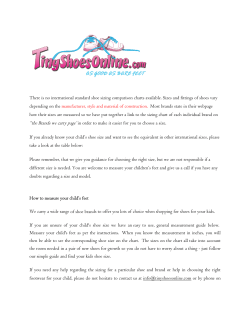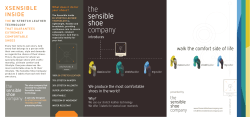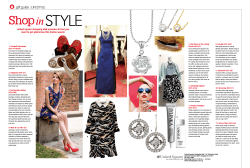
FOOTPRINTS
FOOTPRINT S APRIL 2015 A N INFORM ATION A L NE WSLE T TER FOR PATIEN T S OF A PM A MEMBER PODI ATRIS T S SPRING EDITION PLAY IT SAFE WITH TODAY’S PODIATRIST PLAYING SPORTS IS A GREAT WAY TO EXERCISE, SPEND TIME WITH FRIENDS AND FAMILY, AND DEVELOP TEAM-BUILDING SKILLS. BUT DID YOU KNOW THAT ANKLE SPRAINS AND BREAKS ARE AMONG THE MOST COMMON SPORTS INJURIES FOR BOTH ADULTS AND CHILDREN * ? “For many of us, sports are an integral part of our lives. To get the most out of your workout or from playing a favorite sport, it’s important to choose the right footwear for the type of exercise you’ll engage in,” says Phillip Ward, DPM, a podiatrist and president of the American Podiatric Medical Association (APMA). “People should be aware that sports, which require a substantial amount of running, turning, and contact, can translate to injuries. If you or someone you know sustains a foot or ankle-related injury while playing sports, it’s important to see a podiatrist right away.” SPORT S STAT S Unfortunately, there are many myths surrounding foot and ankle injuries, which may cause a patient to delay seeking treatment. Learn more about some of these common myths on page 2. Taken from http://www.safekids.org/we-work-prevent-sports-injuries and http://www.webmd.com/men/features/seven-most-common-sports-injuries * OVER 21 MILLION YOU TH BE T WEEN THE AGES OF 6 AND 17 PL AY T E A M SPOR T S ON A R EGUL AR BA SIS, ACCORDING T O THE SPOR T S & FITNESS INDUSTRY A SSOCIATION. A 2014 ESPN POLL SHOWED THAT 88 PERCEN T OF PAR EN T S HAVE CONCERNS ABOU T THEIR CHILDR EN’S RISK OF INJURY WHIL E PL AYING YOU TH SPOR T S. A 2014 APM A SURVE Y SHOWED THAT 1 IN 4 ADULT S FEEL S UNABL E T O E XERCISE DUE T O FOO T PAIN, AND 39 PERCEN T OF ADULT S SAID THE Y WOULD E XERCISE MOR E IF THEIR FEE T DIDN’T HUR T. This Footprints newsletter is designed to allow each doctor to customize this section with name, address, phone number, and Web site information. Use the "hand" tool to highlight this text and type in your own information. For assistance, email questions to: apma_assist@apma.org ME MBE R HERE ARE THE TOP FIVE MY THS TO STOP BELIEVING NOW: 1 “ IT CAN’T BE BROKEN BECAUSE I CAN MOVE IT.” False. You can walk with certain kinds of fractures. Common examples include breaks in the smaller, outer bone of the lower leg, small chip fractures of the foot or ankle bones, and the often-neglected fracture of the toe. 2 “ IF YOU BREAK A TOE, IMMEDIATE CARE ISN’T NECESSARY.” False. A toe fracture needs prompt attention. X-rays will reveal if it is a simple, displaced fracture or an angulated break. Your podiatrist can develop the right treatment plan once he or she has identified the type of break. 3 “ IF YOU HAVE A FOOT OR ANKLE INJURY, SOAK IT IN HOT WATER IMMEDIATELY.” F alse. Heat promotes blood flow and can cause greater swelling, which can lead to more pain. An ice bag wrapped in a towel is the ideal temporary treatment before you see your podiatrist. 4 “ APPLYING AN ELASTIC BANDAGE TO A SEVERELY SPRAINED ANKLE IS ADEQUATE TREATMENT.” False. Ankle sprains often mean torn or severely overstretched ligaments, and they should receive immediate care. 5 “ THE TERMS ‘FRACTURE,’ ‘BREAK,’ AND ‘CRACK’ ARE ALL DIFFERENT.” False. All of those words are appropriate for describing a broken bone. R EMEMBER, A DELAY IN TREATMENT CAN CAUSE TOE DEFORMITIES AND OTHER PODIATRIC PROBLEMS. DOES THE SHOE FIT THE SPORT? It’s important to choose the right footwear for your activity. Sneakers made for tennis players will provide different support and traction than cleats made for football players. WHAT DO I LOOK FOR? BASKETBALL, TENNIS, VOLLEYBALL: A thick, stiff sole that gives support while running and landing jumps. Basketball players should look for high ankle construction that supports the ankle during quick changes in direction. Volleyball players should look for a lighter shoe, with less midsole support for quick starts and stops. FOOTBALL AND LACROSSE: A good amount of high ankle support is especially important for lineman and other players who make frequent sideways movements during play. Football and lacrosse players should have shoes with proper traction on a grassy field, in both wet and dry conditions. Shoes with proper traction can help prevent injury. SOCCER: Soccer shoes should have a good-quality footbed, which can help provide proper arch support. Make sure they feature the stud type for the ground that will be played on most often: soft, hard, firm, or turf. Also, use molded rubber cleats rather than the screw-on variety. BASEBALL AND SOFTBALL: Shoes should offer plenty of arch support. If you experience arch pain, try using customized shoe inserts called orthotics. Baseball and softball shoes should have no more than a half inch of space between the big toe and the end of the shoe. Metal baseball spikes should not be used by athletes younger than 13. RUNNING: A good running shoe should provide maximum shock absorption to help avoid injury. It is also important to match your shoe to your foot’s arch type (high, medium, low). Replace your running shoes after 300-500 miles. PRO TIP: DO NOT USE HAND-ME-DOWN SHOES; ILL-FITTING FOOTWEAR INCREASES THE DANGER OF ANKLE INJURIES. D O C T O R S O F P O D I AT R I C M E D I C I N E A R E P O D I AT R I C P H Y S I C I A N S A N D S U R G E O N S , A L S O K N O W N A S P O D I AT R I S T S , Q U A L I F I E D B Y T H E I R E D U C AT I O N , T R A I N I N G , A N D E X P E R I E N C E T O D I A G N O S E A N D T R E AT C O N D I T I O N S A F F E C T I N G T H E F O O T, A N K L E , A N D R E L AT E D S T R U C T U R E S O F T H E L E G . T HIS PAT IEN T INF OR M AT ION NEWSL E T T ER IS SUPP OR T ED BY A N EDUC AT ION A L GR A N T F ROM SPENCO, INC . A ME R IC A N P ODI AT R IC ME DIC A L A S S OC I AT ION 9312 OL D G EOR G E T OWN R OA D B E T HE S DA , MD 20814-1621 • W W W. A PM A .OR G •
© Copyright 2025
















